I usually like Wednesdays, the work week is half over and the coaster is going down the tracks. I also like Bactrian Camels a lot, hump day always makes me think of them. Today started out like any other day, (watch out when I start a blog like this you know it isn't going to be good). I got up at 5:30 am (as usual) and let the Border Collies out. The Border Collies wake up about 15 minutes before me and run from the bed to the door knowing that there is "stuff to do" outside. I got up and made coffee. Got some wood piled into the outside wood furnace; it is so cold. I am really ready for spring at this point, enough of winter. Then I let the dog boarders out into the kennels and head for the barn.
By the time I get outside, I can always hear the roosters crowing and the horses shuffling around their stalls. It isn't light yet but all of the animals know that I am coming and we all look forward to getting the day started. I like doing morning chores, it is just the critters and I in the a.m. Animals love to wake up and I have the best reason to get out of bed every morning. I usually get up before the alarm clock lets me know that I need to be out of bed. This morning wasn't much different than it has been for the last 3 weeks. First, I take hay out back and let the horses out. Then I put the llama grain and hay out in the front courtyard. Then I open the door so the llamas can go outside (weather pending).
The llamas love going outside but we lock them inside at night. I don't want them sleeping outside when it is this cold; I want them burning calories to live, not stay warm. I always stand by the door as all 98 llamas go bouncing by. Now since they know that there is grain out there waiting, the llamas have a "take no prisoner" approach to being the first 40 outside. When I first grained the NY 100 a week after they arrived from Montana, they walked through the grain. The llamas really didn't even know what it was. They are now getting free choice hay and water 24 hours a day and grain once a day. They also get free choice Stillwater Llama Minerals, which they love. By this weekend, I want to start graining them twice a day. With llamas starved this bad, you must take things slow. They didn't starve over night and getting them built back up will take time also.
The last thing that I do before getting my coffee is physical therapy with the llama that was too weak to walk upon arrival almost 3 weeks ago. I will always try to save a llama if they have "the look" in their eyes that they want to live. Unfortunately, with most llamas, once they go down into a kush....they almost never get back up for long. I had made it my personal mission to save this guy and get him back up on his feet. I felt that he had survived way too much to die in NY when he was home free on llama easy street. This morning, "Llama 99" as I've been calling him didn't look at me with his same "Wes we can do this" look in his eyes. I had built him a llama bouncy bounce with a sling and elastic straps, and with his new jacket (donated by Useful Llama Supplies). He was the best dressed llama in the barn. This morning he had the "Wes, when are you going to let me die?" look in his eyes. I told him that it was cold, told him that he was in a bad mood because the blood wasn't circulating yet and went through the stretches and production that I have done for almost the last 3 weeks before I could enjoy a cup of coffee for ten minutes before I have to get showered and dressed for school. I thought that he was just having a crappy morning, it happens to all of us.
At 11:15 today I ran home to meet with another great reporter from the Greenville News. NY Ag and Markets had just stopped at the farm, I'll catch up with them when they have an appointment. Cornell University is sending out 20+ vets on Feb 17th to help me give the llamas their vaccinations and parasite medications. We are also going to read microchips and take photos for the Beekman Boys Fundraiser on that day. As the reporter and I went into the barn, I realized that Llama Number 99 wasn't doing well in the chute. I immediately knew he died shortly after I left him this a.m. after physical therapy. I knew that he was saying good bye this a.m. and had given up the fight and will to live. I was angry that he had tried so hard and given up. I have only had one other llama get up after being down that long, maybe I should have euthanized him instead of giving him almost three weeks to try to get up. At least he died knowing that he was in a great place with lots of food, surrounded by the llamas he had known for years in Montana. He died knowing that his friends and their story would live on. I am selfish, I wanted him to live so I could say I saved him....sometimes you just have to let things go you can't control. I have to go now, I cant write anymore and as I told the reporter that was with me.....few people have ever seen me cry. WES
By the time I get outside, I can always hear the roosters crowing and the horses shuffling around their stalls. It isn't light yet but all of the animals know that I am coming and we all look forward to getting the day started. I like doing morning chores, it is just the critters and I in the a.m. Animals love to wake up and I have the best reason to get out of bed every morning. I usually get up before the alarm clock lets me know that I need to be out of bed. This morning wasn't much different than it has been for the last 3 weeks. First, I take hay out back and let the horses out. Then I put the llama grain and hay out in the front courtyard. Then I open the door so the llamas can go outside (weather pending).
The llamas love going outside but we lock them inside at night. I don't want them sleeping outside when it is this cold; I want them burning calories to live, not stay warm. I always stand by the door as all 98 llamas go bouncing by. Now since they know that there is grain out there waiting, the llamas have a "take no prisoner" approach to being the first 40 outside. When I first grained the NY 100 a week after they arrived from Montana, they walked through the grain. The llamas really didn't even know what it was. They are now getting free choice hay and water 24 hours a day and grain once a day. They also get free choice Stillwater Llama Minerals, which they love. By this weekend, I want to start graining them twice a day. With llamas starved this bad, you must take things slow. They didn't starve over night and getting them built back up will take time also.
The last thing that I do before getting my coffee is physical therapy with the llama that was too weak to walk upon arrival almost 3 weeks ago. I will always try to save a llama if they have "the look" in their eyes that they want to live. Unfortunately, with most llamas, once they go down into a kush....they almost never get back up for long. I had made it my personal mission to save this guy and get him back up on his feet. I felt that he had survived way too much to die in NY when he was home free on llama easy street. This morning, "Llama 99" as I've been calling him didn't look at me with his same "Wes we can do this" look in his eyes. I had built him a llama bouncy bounce with a sling and elastic straps, and with his new jacket (donated by Useful Llama Supplies). He was the best dressed llama in the barn. This morning he had the "Wes, when are you going to let me die?" look in his eyes. I told him that it was cold, told him that he was in a bad mood because the blood wasn't circulating yet and went through the stretches and production that I have done for almost the last 3 weeks before I could enjoy a cup of coffee for ten minutes before I have to get showered and dressed for school. I thought that he was just having a crappy morning, it happens to all of us.
At 11:15 today I ran home to meet with another great reporter from the Greenville News. NY Ag and Markets had just stopped at the farm, I'll catch up with them when they have an appointment. Cornell University is sending out 20+ vets on Feb 17th to help me give the llamas their vaccinations and parasite medications. We are also going to read microchips and take photos for the Beekman Boys Fundraiser on that day. As the reporter and I went into the barn, I realized that Llama Number 99 wasn't doing well in the chute. I immediately knew he died shortly after I left him this a.m. after physical therapy. I knew that he was saying good bye this a.m. and had given up the fight and will to live. I was angry that he had tried so hard and given up. I have only had one other llama get up after being down that long, maybe I should have euthanized him instead of giving him almost three weeks to try to get up. At least he died knowing that he was in a great place with lots of food, surrounded by the llamas he had known for years in Montana. He died knowing that his friends and their story would live on. I am selfish, I wanted him to live so I could say I saved him....sometimes you just have to let things go you can't control. I have to go now, I cant write anymore and as I told the reporter that was with me.....few people have ever seen me cry. WES






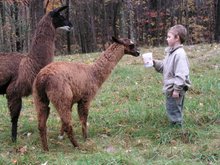
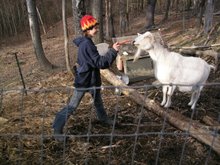
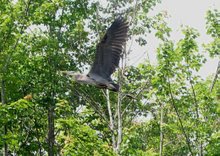
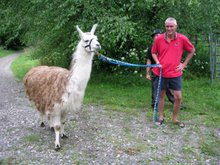
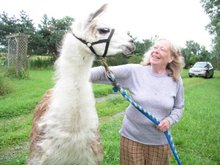
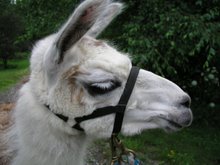




4 comments:
We're very sorry, Wes. In #99's eyes, you were the animal who helped him. He didn't know that death was coming, but he knew that his life had gotten better.
Josh, Brent, and Polka Spot
Hugs to you...what great work you're doing. 99 died k owing you loved him. What more is there for any of us?
The only way forward is to keep walking and to honor the departed by caring for the living.
G-d Bless you for the work you do, for the love you give, and for the lives you work so hard to save.
There is a special place for you in this world, and over the Rainbow bridge with the animals that have left.
Post a Comment